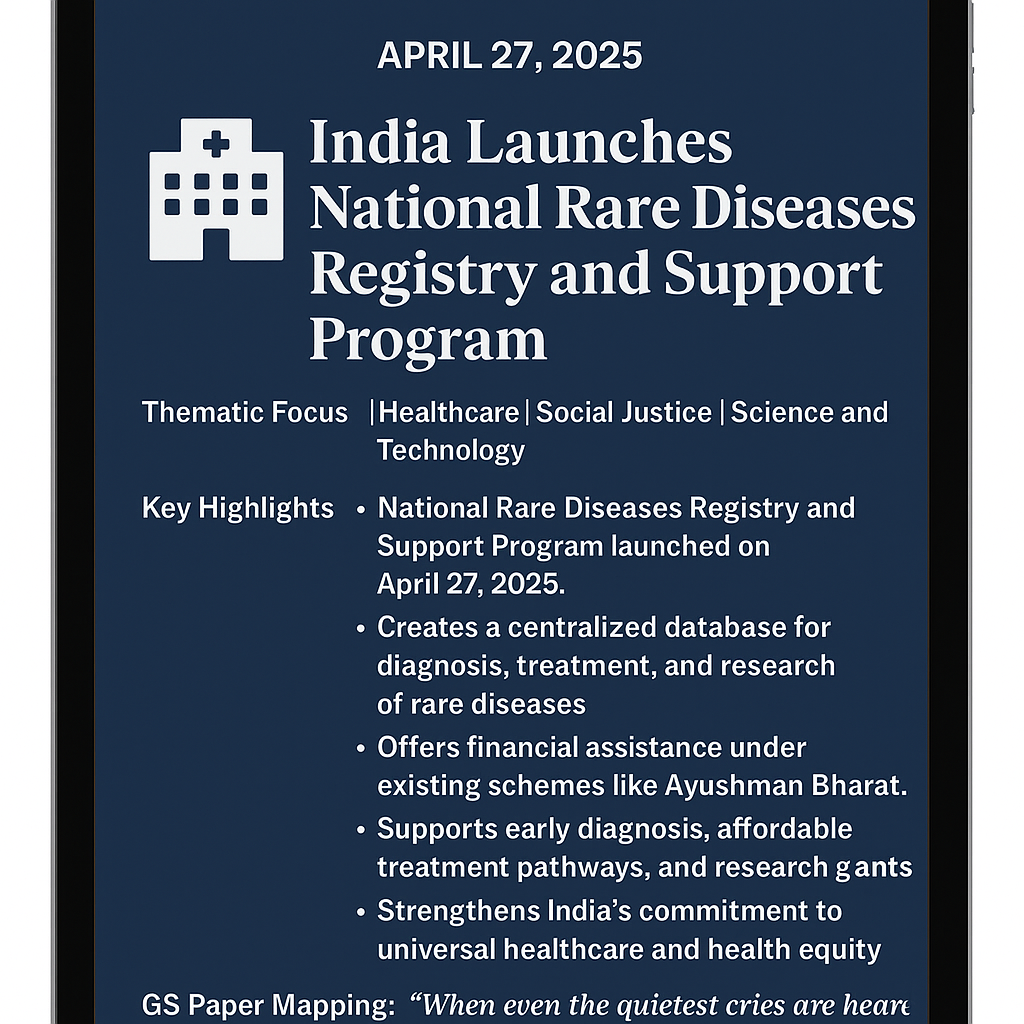
📅 May 5, 2025, Post 1: New Biodiversity Rules for Fair Benefit Sharing | Mains Essay Attached | Target IAS-26 MCQs Attached: A complete Package, Dear Aspirants!
New Biodiversity Rules for Fair Benefit Sharing

NATIONAL HERO — PETAL 001
🗓️ May 5, 2025
Thematic Focus: Biodiversity 🌱 | Governance ⚖️
🌿 Opening Whisper
When nature gives, we must return — not just in gratitude, but in justice.
Key Highlights
• The National Biodiversity Authority (NBA) has notified the Biological Diversity Regulation, 2025 to streamline benefit sharing from the use of biological resources and associated knowledge.
• Access and Benefit Sharing (ABS) is the principle that those who use biodiversity must share benefits with the communities that conserve it. This stems from the Convention on Biological Diversity (CBD).
• The rules are operationalized under India’s Biological Diversity Act, 2002 and its 2023 Amendment.
• Turnover-based sharing slabs:
1. Below ₹5 crore: Exempt
2. ₹5–50 crore: 0.2% of gross ex-factory sales
3. ₹50–250 crore: 0.4% of turnover
4. Above ₹250 crore: 0.6% of turnover
• Companies with over ₹1 crore turnover must submit annual resource use statements.
• Digital Sequence Information (DSI) is now covered, aligning with COP16 decisions — earlier, only physical resources were included.
• Cultivated medicinal plants (as notified) are exempt, promoting sustainability.
• For high-value resources (like red sanders, sandalwood), 5%–20% of proceeds must be shared.
• In IPR filings, use of biodiversity must be disclosed and benefits shared accordingly.
• Benefit distribution:
🔹 10–15% stays with NBA
🔹 Remainder flows to local communities via Biodiversity Management Committees (BMCs)
🧭 GS Paper Mapping
• GS Paper 3 – Environment & Ecology
🔹 Biological Diversity Act, 2002
🔹 Nagoya Protocol and CBD
🔹 Environmental Governance and Sustainable Use
🔹 Digital Bioresources and DSI
• GS Paper 2 – Governance
🔹 Role of regulatory bodies like NBA
🔹 Decentralized decision-making via BMCs
💭 A Thought Spark — by IAS Monk
How much do we owe the forest for its silence, the river for its song, or the seed for its future? These new rules do not just protect — they repay.
High Quality Mains Essay For Practice :
Word Limit 1000-1200
Biodiversity and the Moral Imperative of Justice
“When nature gives, we must return — not just in gratitude, but in justice.”
This poetic call is more than sentiment — it is a summons to humanity’s conscience. In the intricate dance of life on Earth, biodiversity is the stage, the performers, and the rhythm. From microbial life under the soil to vast rainforests teeming with species, nature gives freely — oxygen, water, food, climate regulation, medicinal knowledge, and spiritual sustenance. But the question confronting us now is not merely about conserving biodiversity — it is about whether we return nature’s generosity with fairness, humility, and justice.
Understanding Biodiversity: The Web of Life
Biodiversity, simply put, is the variety of life on Earth — across genes, species, and ecosystems. It is what makes the Amazon rainforest resilient, what nourishes the Indian monsoon, what enriches tribal knowledge systems, and what allows the global food chain to adapt to change. It is not an ornamental feature of Earth — it is foundational.
India, a megadiverse country, hosts nearly 8% of the world’s known flora and fauna, despite covering only 2.4% of the Earth’s surface. The country’s 10 biogeographic zones — from the Himalayas to the Western Ghats — are home to endangered species, endemic plants, and ancient agricultural biodiversity preserved by indigenous communities.
Yet, the threats are mounting. Deforestation, pollution, invasive species, urban sprawl, and climate change are unraveling this web. According to the Global Assessment Report of the Intergovernmental Science-Policy Platform on Biodiversity and Ecosystem Services (IPBES), over one million species are at risk of extinction. This is not merely ecological loss — it is civilizational danger.
From Gratitude to Justice: Reframing Our Relationship with Nature
The phrase “not just in gratitude, but in justice” invites a profound shift. Gratitude acknowledges benefit; justice demands reciprocity. For centuries, indigenous and tribal communities in India and across the world have nurtured ecosystems not because of regulation but because of deep-rooted ethics — seeing rivers as mothers, forests as ancestors, and animals as cousins. Their worldview embodied both gratitude and justice.
Modern governance, however, often substitutes exploitation for stewardship. Natural capital is seen through an economic lens alone. But biodiversity is not a resource warehouse — it is a shared inheritance. Justice, in this context, includes three dimensions:
1. Inter-species Justice
We share this planet not only with other humans but with millions of life forms. Destroying habitats and driving species to extinction is not just shortsighted — it is unethical. We owe other species a right to exist, thrive, and evolve. This is the justice of co-existence.
2. Intra-generational Justice
Communities that depend directly on biodiversity — such as forest dwellers, pastoralists, coastal fishers, and tribal societies — are often those least responsible for its depletion, but most impacted by its loss. Fair distribution of benefits from biodiversity, such as under the Biological Diversity Act and Nagoya Protocol, is a moral obligation.
3. Inter-generational Justice
Future generations have a right to inherit a planet as rich and vibrant as the one we enjoyed. Unsustainable practices today — monoculture farming, overfishing, or unregulated bioprospecting — rob them of that right. Justice demands restraint now for freedom later.
Policy Interventions: A Glimpse of Progress
India has been at the forefront of biodiversity legislation. The Biological Diversity Act, 2002, created institutional mechanisms like the National Biodiversity Authority and local Biodiversity Management Committees (BMCs). The recent Biological Diversity (Amendment) Act, 2023 and the 2025 Benefit Sharing Regulations seek to simplify compliance and expand digital sequence information (DSI) into the fold — a progressive move aligned with global standards.
Furthermore, People’s Biodiversity Registers (PBRs) have been created across villages, documenting local biological resources and knowledge. They represent a living bridge between policy and people.
Globally, India is a signatory to the Convention on Biological Diversity (CBD) and the Nagoya Protocol, committing to Access and Benefit Sharing (ABS) principles. The Kunming-Montreal Global Biodiversity Framework (2022), which aims to halt biodiversity loss by 2030, is another landmark.
However, implementation gaps, limited awareness at the grassroots, weak coordination between ministries, and conflicts between conservation and development projects remain stumbling blocks.
Nature’s Economy: Valuing the Invisible
Justice also implies recognizing the true worth of biodiversity. Natural capital accounting — integrating ecological value into GDP calculations — is gaining traction. For instance, forests do not merely provide timber but also sequester carbon, regulate rainfall, and nurture pollinators. Wetlands purify water and cushion floods. These services must reflect in national economic planning.
India’s State of Forest Report, National Mission for Sustainable Agriculture, and CAMPA funds are positive steps. But a deeper shift is needed — from extractive to regenerative economies.
The International Seabed Authority’s debate on deep-sea mining, Amazon deforestation for soybean, or India’s hydro projects in fragile ecosystems — all point to the tension between growth and guardianship. Justice must tilt the scale towards long-term sustainability.
Technology, Communities, and Education: Triad of Hope
Biodiversity protection does not mean halting development — it means redefining it. Technology can aid biodiversity monitoring through satellite mapping, AI-based species tracking, and early-warning systems for habitat threats.
Yet, the heart of conservation is community. India’s sacred groves, tribal conservation practices like Ziro Valley’s paddy-fish cultivation, or Nagaland’s community-led hunting bans, are models of grassroots biodiversity justice.
Education must nurture ecological consciousness. Textbooks, urban curricula, and civil service training must integrate biodiversity ethics — not just facts. Every citizen must feel a stake in the living world.
Conclusion: Giving Back with Justice
Biodiversity is not optional; it is existential. When we lose a species, we lose a story, a medicine, a song, a possible future. The essay prompt’s wisdom — “When nature gives, we must return — not just in gratitude, but in justice” — demands that humanity act not as conquerors of nature, but as trustees.
Justice for biodiversity is not a bureaucratic clause — it is a sacred duty. Let our laws be just, our industries be accountable, our traditions be revived, and our choices be humble. In doing so, we will not only honor what nature gives — we will ensure that it keeps giving.
Quote to End With
“The Earth does not belong to us; we belong to the Earth.” — Chief Seattle
Target IAS-26: Daily MCQs :
📌 Prelims Practice MCQs
Topic:
MCQ 1 – Type 1: How many of the above statements are correct?
Q. Consider the following statements regarding the Biological Diversity (Access and Benefit Sharing) Regulation, 2025:
• 1) The regulation exempts companies with an annual turnover below ₹1 crore from filing benefit-sharing statements.
• 2) Digital Sequence Information (DSI) is now included under the scope of benefit-sharing.
• 3) Cultivated medicinal plants, even if unlisted, are exempt from the benefit-sharing framework.
• 4) High-value species like red sanders and sandalwood may require up to 20% of auction proceeds to be shared.
Options:
A) Only two
B) Only three
C) All four
D) Only one
🌀 Didn’t get it? Click here (▸) for the Correct Answer & Explanation
✅ Correct Answer: A) Only two
🧠 Explanation:
• 1) ❌ Incorrect – Companies with turnover above ₹1 crore must file annual statements. The exemption applies only to benefit sharing for turnovers below ₹5 crore, not from filing statements.
• 2) ✅ Correct – DSI (Digital Sequence Information) is now included under benefit-sharing obligations.
• 3) ❌ Incorrect – Only notified cultivated medicinal plants are exempt; unlisted ones are not.
• 4) ✅ Correct – For high-value resources, up to 20% of proceeds must be shared in case of commercial exploitation.
✅ Only two statements — 2 and 4 — are correct.
MCQ 2 – Type 2: Two Statements Based
Q. Consider the following statements:
• 1) The new 2025 regulation includes clear turnover-based benefit-sharing slabs.
• 2) Under the regulation, the National Biodiversity Authority retains 50% of all benefit-sharing proceeds.
Options:
A) Only 1 is correct
B) Only 2 is correct
C) Both are correct
D) Neither is correct
🌀 Didn’t get it? Click here (▸) for the Correct Answer & Explanation.
✅ Correct Answer: A) Only 1 is correct
🧠 Explanation:
• 1) ✅ Correct – The new rules introduce well-defined slabs for turnover-based sharing (e.g., 0.2%, 0.4%, 0.6%).
• 2) ❌ Incorrect – NBA retains only 10–15% of benefit-sharing funds. The rest goes to local BMCs.
MCQ 3 – Type 3: Which of the statements is/are correct?
Q. Which of the following statements is/are correct about India’s biodiversity benefit-sharing mechanism?
• 1) India implements the ABS principle through the Biological Diversity Act, 2002.
• 2) The 2025 rules include DSI to align with COP16 outcomes.
• 3) The Nagoya Protocol is not legally binding on member countries.
• 4) Companies involved in IPR must disclose biodiversity usage.
Options:
A) 1, 2, and 4 only
B) 1 and 3 only
C) 2, 3, and 4 only
D) All four
🌀 Didn’t get it? Click here (▸) for the Correct Answer & Explanation
✅ Correct Answer: A) 1, 2, and 4 only
🧠 Explanation:
• 1) ✅ Correct – India enforces the principle through its national Biological Diversity Act.
• 2) ✅ Correct – Inclusion of DSI aligns with global outcomes of COP16.
• 3) ❌ Incorrect – The Nagoya Protocol is legally binding.
• 4) ✅ Correct – IPR applicants must disclose and share benefits related to biodiversity use.
MCQ 4 – Type 4: Direct Fact
Q. The Nagoya Protocol, associated with benefit-sharing of biodiversity, was adopted in which year?
Options:
A) 2002
B) 2010
C) 2014
D) 2023
🌀 Didn’t get it? Click here (▸) for the Correct Answer & Explanation.
✅ Correct Answer: B) 2010
🧠 Explanation:
• The Nagoya Protocol was adopted in 2010 in Japan and came into force in 2014. It supplements the Convention on Biological Diversity (CBD).


















